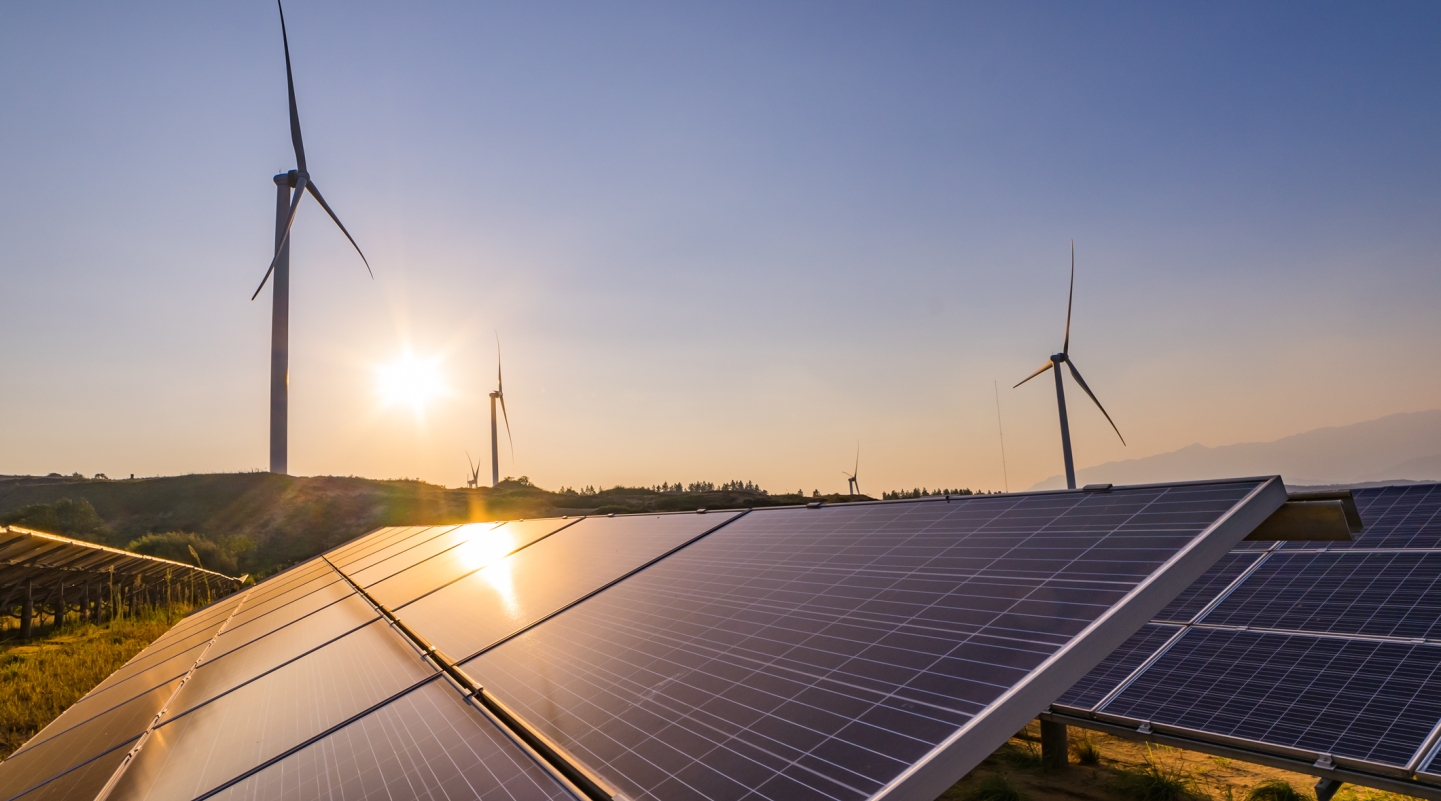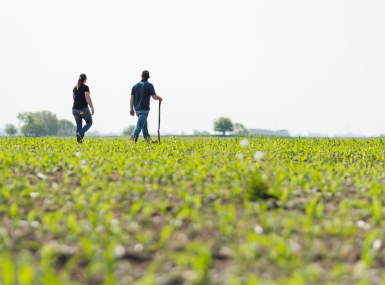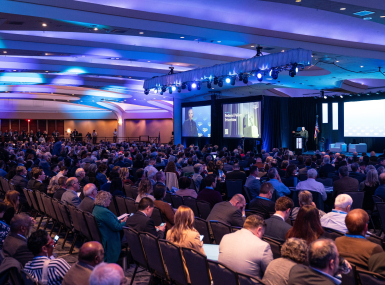Legislative Analysis for Counties: The Inflation Reduction Act

Author
Upcoming Events
Related News
Executive Summary
On August 16, President Biden signed the Inflation Reduction Act (IRA) into law. The IRA aims to reduce the federal deficit, cut greenhouse gas emissions and lower health insurance related costs while increasing health insurance coverage for vulnerable Americans.
The IRA, which is a product of months-long congressional negotiations following the passage of the Build Back Better Act (BBBA) in the U.S. House of Representatives last year, would reduce federal deficits by $102 billion between 2022 and 2031 – the lifespan of the law – according to estimates by the nonpartisan Congressional Budget Office (CBO).
The IRA seeks to reduce greenhouse gas emissions by 40 percent below 2005 levels by 2030. It does so by making significant investments in climate and environment programs and providing tax incentives to boost the development and deployment of clean energy. These investments include multiple direct funding opportunities for counties to save money while reducing emissions.
The law also includes several measures related to healthcare.
These three areas – tax reform and deficit reduction, climate and energy, and healthcare – and their impact on counties are discussed further below.
The IRA offers counties the opportunity to pursue clean energy initiatives and reduce emissions through new competitive grant programs, local resiliency investments and clean energy tax credits.
Among our numerous responsibilities, environmental stewardship is a primary function of county governments to create healthy, safe and vibrant communities for our residents. This includes revitalizing contaminated sites to ensure safe and equitable neighborhoods, providing waste and recycling services to minimize pollution and implementing land use and energy policies to promote sustainable communities, along with many other duties.
The IRA will strengthen county resiliency and better prepare us to address risks in a manner that can minimize the impact on local residents and businesses, while helping counties save money
Major Provisions For Counties
- Allows counties to elect for direct pay in lieu of certain clean energy tax credits
- Fails to provide relief from the $10,000 cap on the state and local tax (SALT) deduction implemented in the 2017 Tax Cuts and Jobs Act
- Extends Affordable Care Act (ACA) premium subsidies to 2025
- Caps annual out-of-pocket cost of prescription drugs for Medicare beneficiaries each year at $2,000
- Fails to enact the Medicaid Reentry Act
- Provides $5.95 billion to support the nation’s farmers, ranchers and foresters
- Provides $4 billion to the Bureau of Reclamation to award grants to counties and others responsible for water conservation to mitigate the impacts of drought in the West
- Establishes a $3 billion Environmental Justice Block Grant Program within the U.S. Environmental Protection Agency
- Invests $27 billion in a Greenhouse Gas Reduction Fund at EPA to provide financial assistance to counties to support projects to reduce greenhouse gas emissions
- Provides $350 million to the Federal Permitting Improvement Steering Council’s environment review improvement fund to streamline and expedite the federal permitting process
IRA at a Glance
The IRA invests $369 billion in climate and energy, aiming to reduce greenhouse gas emissions by 40 percent below 2005 levels by 2030. It establishes new programs that provide direct funding opportunities for counties to engage in clean energy and climate projects and provides funds for range of issues including air pollution, energy efficiency and carbon emissions.
Additionally, the IRA extends, modifies and establishes several tax incentives to boost the development and deployment of clean energy. Several incentives are now available to local governments under a ‘direct pay’ option, meaning that counties could elect to receive a direct payment from the federal government in lieu of the credit. This presents new opportunities for counties interested in pursuing and financing renewable and clean energy projects.
Local governments play a crucial role in responding to climate change and reducing national emissions levels through the deployment of clean energy, among other initiatives. Many counties engage and partner with local utilities in energy planning, including utility-scale renewable energy projects, key regulatory issues, grid modernization and storage and energy assurance strategies.
Intergovernmental and cross-sector collaboration between federal, state and local partners is critical to ensuring the development and deployment of accessible and affordable clean energy, and the funding provided in the IRA helps to further and strengthen such collaboration.
The IRA includes several tax measures to offset the new climate and energy spending. It invests $80 billion to enhance Internal Revenue Service taxpayer services, operations and enforcement, which the CBO estimates will result in $203 billion in increased revenue over 10 years. Additionally, the legislation imposes a 15 percent alternative minimum tax for corporations that earn more than $1 billion with an exception for companies owned by private equity and a includes 1 percent excise tax on stock buybacks.
The IRA caps the annual out-of-pocket costs of prescription drugs for Medicare beneficiaries at $2,000, provide free vaccines for Medicare beneficiaries and extend ACA premium subsidies to 2025. These measures are critical for counties as key providers of local public health services and frontline service providers for the medically vulnerable.
Notably for counties, the IRA does not include the enactment of the Medicaid Reentry Act, unlike BBBA. A key priority for counties across the country, the Medicaid Reentry Act would amend the Federal Medicaid Inmate Exclusion Policy (MIEP) by authorizing incarcerated individuals to receive services covered by Medicaid 30 days prior to their release from jail.
IRA by the Numbers

Section by Section Analysis For Counties
*Please note that while most funds are appropriated in FY 2022, the year through which these funds are available varies. In many instances, federal agencies will be able to decide when and how much funding to spend within the available funding window.
Health Provisions
Effective in FY 2025, the IRA caps the cost of prescription drugs for individuals on Medicare at $2,000 per year, with the option to distribute those costs over monthly payments.
As owners and operators of the systems of care in our communities, counties support a variety of strategies to assist in cost containment for prescription drugs. Seniors and individuals with disability who are able to receive prescription drugs at a reduced rate under Medicare are more likely to have better health outcomes and less likely to be admitted into county health facilities such as hospitals and the emergency room.
Under the IRA, there is no coinsurance or other cost-sharing for all Centers for Disease Control and Prevention (CDC) recommended vaccines provided to Medicare beneficiaries, effective in FY 2023.
Counties, as key providers of local public health services and frontline service providers for the medically vulnerable, continue to administer essential vaccinations to residents, regardless of their insurance status. Federal support for the cost of administering COVID-19 vaccines and other important vaccinations increases communal protection from infectious diseases while decreasing the cost burden of uncompensated medical care
The IRA extends for three-years the American Rescue Plan (ARP) provision that broadened eligibility for Affordable Care Act (ACA) health insurance subsidies to individuals purchasing health care coverage on the ACA Marketplace with incomes over 400 percent of the federal poverty threshold. The temporary provision was set to expire at the end of 2022 and would be extended through FY 2025.
Without the ARP premium tax credits, more than half of people with incomes between 400 and 500 percent of the Federal Poverty Line (FP) - $52,000 to $64,000 for an individual or $106,000 to $132,000 for a family of four – would pay over 15 percent of their incomes in premiums and nearly third would pay over 20 percent of their income.
For people 600 percent FPL, 28 percent would pay over 15 percent of their income and some would face net premiums that could exceed up to 25 percent of their income in 2023, according to CMS data.
Important for counties, these subsidies allow low-income individuals to obtain affordable health insurance based on their income, reducing the number of uninsured and medically indigent individuals seeking care in county health facilities.
Agriculture Provisions
$13.4 billion over four years
Provides Funding for the Environmental Quality Incentives Program | $8.45 billion over four years
The IRA would provide $8.45 billion over four years for the U.S. Department of Agriculture’s (USDA) Environmental Quality Incentives Program (EQIP), with prioritization for proposals that improve soil quality, reduce emissions or mitigate greenhouse gases associated with agriculture production.
EQIP provides financial and technical assistance to agricultural producers and non-industrial forest managers to address natural resource concerns and bolster environmental quality.
Funding is appropriated at the following levels:
- FY 2023: $250 million
- FY 2024: $1.75 billion
- FY 2025: $3 billion
- FY 2026: $3.45 billion
Provides Funding for the Conservation Stewardship Program | $3.25 billion over four years
The IRA would provide $3.25 billion over 4 years for USDA’s Conservation Stewardship Program (CSP) for conservation programs that improve soil quality, reduce emissions or mitigate greenhouse gas emissions.
CSP provides technical and financial assistance to agricultural and forest producers to bolster their conservation efforts by adoption additional activities and maintaining their current baseline of conservation.
Funding is appropriated at the following levels:
- FY 2023: $250 million
- FY 2024: $500 million
- FY 2025: $1 billion
- FY 2026: $1.5 billion
Provides Funding for the Agricultural Conservation Easement Program | $1.4 billion over four years
The IRA would provide $1.4 billion over four years for USDA’s Agricultural Conservation Easement Program (ACEP) for conservation practices that mitigate greenhouse gas emissions.
ACEP aims to protect the agricultural viability and related conservation efforts by limiting nonagricultural uses that can negatively impact these practices and by restoring and conserving grazing land and wetlands.
Funding is appropriated at the following levels:
- FY 2023: $100 million
- FY 2024: $200 million
- FY 2025: $500 billion
- FY 2026: $600 billion
Counties recognize the need to protect our nation’s most environmentally sensitive lands and waters. Programs such as the Environmental Quality Incentive Program, Conservation Reserve Program, Wetlands Reserve Program, Conservation Security Program and others are important sources for technical assistance and are needed to help communities implement many important conservation measures.
$1.4 billion in FY 2022
The IRA provides $1 billion for conservation technical assistance through the Natural Resources Conservation Service. In addition, IRA provides $300 million to establish a new program with USDA’s Greenhouse Gas Inventory and Assessment Program to assess the impact of this conservation technical assistance on reducing greenhouse gas emissions
The funding is available through FY 2031.
Counties support USDA’s NRCS and the valuable technical assistance their field offices provide. The NRCS plays a critical role for counties by addressing local conservation issues pertinent to county governments as well as Soil and Water Conservation Districts.
$1.4 billion in FY 2022
The IRA provides $1 billion for conservation technical assistance through the Natural Resources Conservation Service. In addition, IRA provides $300 million to establish a new program with USDA’s Greenhouse Gas Inventory and Assessment Program to assess the impact of this conservation technical assistance on reducing greenhouse gas emissions
The funding is available through FY 2031.
Counties support USDA’s NRCS and the valuable technical assistance their field offices provide. The NRCS plays a critical role for counties by addressing local conservation issues pertinent to county governments as well as Soil and Water Conservation Districts.
$2.18 billion over six years
The IRA provides $1 billion for Rural Renewable Energy Loans and $1.18 billion over six years for Rural Energy for American Grants. These programs provide financing to agricultural producers and rural small businesses for renewable energy systems or to make energy efficiency improvements.
The $1.18 billion for the Rural Energy for America Grant program is provided at the following levels:
- FY 2022: $144.75 million
- FY 2023: $31.81 million
- FY 2024: $1.81 million
- FY 2025: $31.81 million
- FY 2026: $31.81 million
- FY 2027: $31.81 million
Counties support comprehensive legislation to encourage and enable American agricultural to provide at least 25 percent of the total energy, including wind and solar, consumed in the United States by 2025 while continue to produce abundant, safe and affordable food and fiber.
$9.7 billion in FY 2022
Electric cooperatives serve 42 million people, including 92 percent of persistent poverty counties. The funding provided by IRA is targeted toward helping rural electric co-ops reduce greenhouse gas emissions and improve energy efficiency and increase resiliency within our rural communities.
Rural electric cooperatives that serve counties would be eligible to apply.
Funding is available through FY 2031.
$500 million in FY 2022
The IRA establishes a competitive grant program to bolster agricultural commodity-based fuels including infrastructure for creating, storing, supplying and distributing biofuels or increasing capacity for the use of biofuels in homes. Funding for the program will be available through FY 2031.
Counties would be eligible to apply directly to USDA for funding under the program.
Biomass fuels (ethanol, bio-diesel) are paramount not only to the reduction of pollution in counties throughout the nation, but also serve as revenue generators for many farmers that are struggling with low prices for their crops and increased costs of production. Counties support Congressional action that encourages and enhances their use and development.
Biomass includes agricultural byproducts such as renewable plant materials (feed grains, other organic commodities, other plans and tress, algae), waste material (crop residue, other vegetative waste material including wood waste and wood residue) and animal waste.
$5.95 in FY 2022
The IRA invests $5.95 billion in financially supporting the nation’s farmers, ranchers and foresters. Programs include:
- $3.1 billion for aid to borrowers with at-risk agricultural operations who have direct or guaranteed loans through the Farm Service Agency
- $2.2 billion to establish a program to compensate farmers, ranchers or forest landowners determined to have experienced discrimination prior to 2021 in USDA farm lending programs
- $125 million for USDA to provide technical assistance, outreach, mediation and training on issues impacting our nation’s farmers, ranchers and forest landowners
- $250 million to improve land access and mitigate the impacts of land loss for producers
- $10 million for USDA to establish racial equity commissions
Funding is available through FY 2031.
Counties support legislation in support of livestock, ranching, production agriculture and other farming industries. Additionally, counties support the mission of the USDA and encourages it to focus on expanding the competitiveness of American agriculture and supporting rural businesses and industries that enhance rural development and quality of life in rural communities.
Climate & Energy Provisions
Clean Energy Tax Credits
The IRA expands, extends and establishes new tax credits in order to advance the development and deployment of renewable energy technologies. Notably for counties, the IRA also allows counties, among other tax-exempt entities, to elect for direct payment in lieu of certain tax credits.
The direct pay option will allow local governments, public utilities and such entities as electric cooperatives to pursue renewable energy projects on their own, without having to rely on outside financing. This provides an opportunity to increase access to renewable energy in counties across the county in a cost-effective manner.
This direct pay option is available for all the tax credits listed in the section below. Please note that the Treasury Department has not yet announced the process by which counties will be able to elect for direct pay.
Credit Type | Credit | Eligible for Direct Pay |
|---|---|---|
CLEAN ELECTRICITY AND REDUCING CARBON EMISSIONS | Extension and Modification of Credit for Electricity Produced from Certain Renewable Resources | X |
Extension and Modification of Energy Credit | X | |
Extension and Modification of Credit for Carbon Oxide Sequestration | X | |
Zero-Emission Nuclear Power Production Credit | X | |
CLEAN FUELS | Clean Hydrogen | X |
CLEAN VEHICLES | Qualified Commercial Clean Vehicles | X |
Alternative Fuel Refueling Property Credit | X | |
INVESTMENT IN CLEAN ENERGY MANUFACTURING AND ENERGY SECURITY | Extension of the Advanced Energy Project Credit | X |
Advanced Manufacturing Production Credit | X | |
INCENTIVES FOR CLEAN ELECTRICITY AND CLEAN TRANSPORTATION | Clean Electricity Production & Clean Electricity Investment Credits | X |
Clean Fuel Production Credit | X |
The production tax credit for electricity from renewables, otherwise known as the PTC, provides a tax credit for the production of electricity from certain renewable energy sources including wind, biomass, geothermal, solar, small irrigation, landfill and trash, hydropower and marine and hydrokinetic energy. Counties that own facilities that produce electricity from these sources can receive a direct payment from the IRS equal to the amount of the credit by making an elective pay election.
The credit is available to eligible facilities that begin construction prior to January 1, 2025 and for the first 10 years of operation. In order for the county to receive a direct payment in lieu of the credit, the facility must be placed into service after December 31, 2022,
The base credit amount 0.3 cents per kilowatt (kW), adjusted annually for inflation. The base credit amount is reduced by one-half for electricity produced from open loop biomass, small irrigation and landfill and trash. Counties should note that the credit is reduced if the facility is financed with tax-exempt bonds, with the maximum reduction set at 15 percent.
Bonus credit amounts are available if certain requirements are met:
- The credit is increased by 5 times for facilities that pay prevailing wages and use registered apprenticeships.
- The credit is increased by 10 percent if the project meets certain domestic content requirements.
- The credit is increased by 10 percent if it is located in an energy community.
Counties can receive a direct payment in lieu of the PTC.
Counties support increased federal resources for researching and developing renewable energy technologies, including wind, solar, geothermal, biomass, electricity from landfill gas and other forms of waste-to-energy which will achieve the objective of clean and safe forms of energy.
The investment tax credit for energy property, otherwise known as the ITC, provides a tax credit for investment in certain renewable energy projects, including fuel cell, solar, geothermal, small wind, energy storage, biogas, microgrid controllers and combined heat and power properties. Counties that invest in eligible renewable energy projects can receive a direct payment from the IRS equal to the amount of the credit by making an elective pay election.
The credit is available to eligible projects that begin construction prior to January 1, 2025.
The base credit amount is 6 percent of the investment, or the county’s basis in the eligible energy property. Counties should note that the credit is reduced if the facility is financed with tax-exempt bonds, with the maximum reduction set at 15 percent. Additionally, the base credit for geothermal heat property is reduced to 5.2 percent in 2033 and 4.4 percent in 2034 and phases out completely in 2035.
Bonus credit amounts are available if certain requirements are met:
- The credit is increased by 5 times for facilities that pay prevailing wages and use registered apprenticeships.
- The credit is increased by up to 10 percentage points if the project meets certain domestic content requirements.
- The credit is increased by up to 10 percentage points if the project is located in an energy community.
Counties can receive a direct payment in lieu of the ITC.
Counties support increased and multifaceted federal efforts to increase renewable energy sources and consumption.
The credit for carbon oxide sequestration provides a tax credit for carbon capture and sequestration, injection for enhanced oil recovery or utilization. Counties that own an eligible facility that own a carbon capture facility can receive a direct payment from the IRS equal to the amount of the credit by making an elective pay election.
Eligible facilities must meet minimum volumes:
- 1,000 metric tons of CO2 per year for direct air capture (DAC) facilities
- 18,750 metric tons of CO2 per year for electricity generating facilities, which must be designed to capture at least 75 percent of the baseline CO2 production
- 12,500 metric tons of CO2 per year for all other facilities
The credit is available for the first 12 years after a facility is placed into service and to facilities placed into service prior to January 1, 2033.
The base credit amount, which is adjusted annually for inflation, is dependent on the end use:
- $17 per metric ton of CO2 captured and sequestered ($36 for DAC facilities)
- $12 per metric ton of CO2 that is captured and injected for enhanced oil recovery ($26 for DAC facilities)
- $12 per metric ton of CO2 that is captured and utilized ($26 for DAC facilities)
A bonus credit amount is available if certain requirements are met:
- The credit is increased by 5 times for facilities that pay prevailing wages and use registered apprenticeships.
Counties can receive a direct payment in lieu of the 45Q credit.
Counties support the federal government’s encouragement of carbon capture and underground storage.
The IRA creates a new tax credit for the production of clean hydrogen at a qualifying facility’s first 10 years of production. Qualifying would include facilities that begin construction before January 1, 2033.
The base rate of the credit is the applicable percentage of $0.60 multiplied by the amount of clean hydrogen produced in a year. The applicable percentage is tied to the lifecycle greenhouse gas emission rate achieved in producing the clean hydrogen. There is also a bonus rate of $3.00 available for facilities that meet certain prevailing wage and apprenticeship requirements.
The credit is reduced for facilities that are financed with tax-exempt bonds. The reduction is the lesser of 15 percent OR the percentage of bond proceeds used to finance the project out of the total capital cost of the project.
Counties can receive a direct payment in lieu of the credit.
Counties support a comprehensive and integrated approach to a national energy policy that accelerates development, research and incentives for alternative and renewable energy, clean energy and energy efficient programs.
The credit for zero-emission nuclear power production provides a tax credit for electricity produced at an eligible nuclear power facility. Eligible nuclear power facilities are those in operation as of August 16, 2022. Counties that own such facilities can receive a direct payment from the IRS equal to the amount of the credit by making an elective pay election.
The credit is available to nuclear power facilities that were in operation as of August 16, 2022 and for electricity produced and sold after December 31, 2023 and before December 31, 2032.
The base credit amount is 0.3 cents per kilowatt hour (kWh), adjusted annually for inflation. The credit amount is reduced when the price of electricity generated at the facility increases.
A bonus credit amount is available if certain requirements are met:
- The credit is increased by 5 times for facilities that pay prevailing wages and use registered apprenticeships.
Counties can receive a direct payment in lieu of the credit.
Counties support nuclear power as a component of a comprehensive national energy policy and encourages the continue research, improvement and development of nuclear power and related technologies that add to its safety and efficiency.
The IRA extends the alternative fuel vehicle refueling property credit – which expired in 2021 – through 2032. The credit applies to the cost of the installation of alternative fuel vehicle refueling property at a business or private residence.
The IRA also expands the credit by establishing a new base credit rate of 6 percent and increasing the credit limit from $30,000 to $100,000. There is also a bonus credit rate of 30 percent if certain prevailing wage and apprenticeship requirements are met.
Additionally, the IRA expands qualified property to include bidirectional charging equipment and charging stations for electric 2- and 3-wheeled motor vehicles, if placed on public roads.
Further, the credit is only available for property installed in a low-income or rural census tract.
Counties can receive a direct payment in lieu of the credit.
Counties support federal policy to ensure the availability of a refueling infrastructure and of competitively priced, reliable alternative fuel and alternative fuel vehicles. Further, counties support an increase in fueling infrastructure stations to support the promotion of alternative fuel vehicles.
The IRA establishes a new advanced manufacturing production tax credit for the production and sale of eligible components of wind and solar structures. Eligible components include solar modules, photovoltaic cells, photovoltaic wagers, solar grade polysilicon, torque tubes or structure fasteners or polymeric backsheets; wind blades, nacelles, towers and offshore foundations; inverters; battery electrode active materials, cells and modules; and critical minerals.
The credit amount is tied to the mass, watt-capacity, sales price or production cost of the component.
The credit is available for components produced and sold prior to 2030 and before 2033. However, the credit for critical minerals is not subject to the phase-out.
Counties can receive a direct payment in lieu of the credit.
Counties support the expanded use of solar, wind and other traditional and renewable energy resources to provide secure, clean, affordable energy by utilizing the best methods available.
The IRA establishes a new, technology-neutral emissions-based incentive that allows taxpayers to choose between a clean electricity investment tax credit or production tax credit. The credit is tied to the greenhouse gas emissions of the electricity generated at any type of power facility if the facility operates at zero emissions.
The credit for the clean electricity PTC is up to 0.5 cents per kWh of electricity produced and sold in the 10 years after the facility is placed into service, while the clean electricity ITC credit is up to 6 percent of the investment in a facility the year it is placed into service. There is a bonus credit of up to 2.5 cents per kWh for the PTC and 30 percent of the investment for the ITC if certain prevailing wage and apprenticeship requirements are met.
There credits expire in 2032 or when emission goals are met.
Counties can receive a direct payment in lieu of the credit.
Counties support research and development of new technologies and commercialization of existing technologies that will contribute to reducing atmospheric carbon emissions.
The IRA establishes a new, technology-neutral clean fuel production credit that is tied to the lifecycle greenhouse gas emissions of the fuel. Fuel qualifies for the credit if its lifecycle emissions are at least 25 percent below the current national average and is produced and sold in the United States. Further, the fuel is required to be transportation grade, but can also be used in other settings including residential applications.
The credit expires on January 1, 2028.
Counties can receive a direct payment in lieu of the credit.
Counties support efforts to decrease reliance on oil by focusing on alternative fuels and supports increased fuel economic standards for trucks and cars to reduce fuel costs and air pollution.
The IRA establishes a new tax credit for eligible commercial clean vehicles, such as zero-emissions buses or garbage trucks. The credit is equal to the 30 percent of the cost of the vehicle or the incremental cost of the vehicle, whichever is lower.
The credit is limited to $7,500 for vehicles weighing less than 14,000 pounds. For vehicles heavier than that, the credit limit is raised to $40,000.
Eligible vehicles include those that are charged by an external source of electricity and have a battery capacity of at least 15 kilowatt hours for vehicles weighing at least 14,000 pounds and 7 kilowatt hours for vehicles weighing less than 14,000 pounds. Mobile machinery and commercial fuel cell vehicles would also be eligible for the credit.
The credit expires on January 1, 2033.
Counties can receive a direct payment in lieu of the credit.
The IRA extends the Advanced Energy Project Credit (48C), providing an additional $10 billion in allocations. 48C is a competitive 30 percent credit for projects that reequip, expand or establish qualifying clean energy manufacturing facilities.
The IRA would also expand the definition of a qualifying facility to include facilities that produce or recycle renewable energy property, grid modernization equipment or carbon capture property.
The American Recovery and Reinvestment Act (ARRA) (P.L. 111-5) provided $2.3 billion in allocations of the credit, but this funding has now been fully allocated.
Counties can receive a direct payment in lieu of the credit.
Greenhouse Gas Emissions
$27 billion in FY 2022
The IRA establishes a Greenhouse Gas Reduction Fund at EPA that provides grants to state and local governments and acts similarly to a national green bank, which encourages the leveraging of public dollars with private financing.
The fund establishes two different types of grant programs. The first is a $7 billion competitive grant program for state and local governments and other eligible entities, to provide financial and technical assistance to enable low-income and disadvantaged communities to deploy or benefit from zero-emission technologies.
The second is a $19.97 billion competitive grant program for nonprofits to either:
- Provide financial assistance to qualified projects and recycle repayments from fees, interest and repaid loans to maintain the financial assistance program; OR
- Provide financial and technical assistance to create or support public or nonprofit entities which would then provide financial assistance to qualified projects
Qualified projects under this second grant program include those that reduce greenhouse gas emissions in partnership with the private sector or through community-led efforts. Additionally, $8 billion of the $19.97 billion is reserved for projects in low-income and disadvantaged communities.
EPA is required to begin awarding grants within six months of the IRA’s enactment. Counties can apply directly to EPA for funding under the first program.
Counties continue to urge the federal government to aggressively pursue and support national and international programs to research, develop and deploy carbon-neutral energy sources to reduce greenhouse gas emissions. Further, counties support federal financial and technical assistance to local governments to help develop and implement local climate change adaption and mitigation plans and projects.
$1.55 billion in FY 2022
The IRA establishes a Methane Emissions Reduction Program at EPA to provide grants, rebates and other financial incentives to encourage industry to reduce methane and other greenhouse gas emissions and mitigate legacy air pollution from petroleum, natural gas systems and conventional wells. Funding under the program can also be used to improve the climate resiliency of local communities, mitigate the health effects of emissions in low-income and disadvantaged communities and support environmental restoration.
Funding is available through FY 2028.
Counties support national and local strategies, including private sector initiatives, to mitigate the impacts of climate change and enhance community resiliency.
$5 billion in FY 2022
The IRA establishes a $5 billion Climate Pollution Reduction Grant Program at EPA, which will award funding to state and local governments and other eligible entities, for greenhouse gas air pollution planning and implementation activities.
Applicants will be required to submit a plan for the reduction of greenhouse gas air pollution including programs, policies, measures and programs to EPA. The Agency will then award funds to selected applicants to carry out those plans.
EPA is required to publish a Notice of Funding Opportunity (NOFO) for the program within nine months of the IRA’s enactment. Counties will be able to apply directly to EPA for funding under the program.
Implementation funding is available through FY 2026 and planning funding is available through FY 2031.
Counites support an increase in federal technical and financial assistance to states and local governments for the development and administration of local air pollution control programs.
$280.5 million in FY 2022
The IRA provides funding for several grant programs at EPA to address air pollution, including:
- Fenceline Air Monitoring and Screening Air Monitoring: $117.5 million for grants to deploy, integrate, support and maintain fenceline air monitoring, screening air monitoring, national air toxics trend stations and other air toxics and community monitoring
- Multipollutant Monitoring Stations: $50 million for grants to expand and maintain the national ambient air quality monitoring network
- Air Quality Sensors in Low-Income and Disadvantaged Communities: $3 million for grants to deploy, integrate and operate air quality sensors in low-income and disadvantaged communities
- Emissions from Wood Heaters: $15 million for grants for testing and other activities to address emissions from wood heaters
- Methane Monitoring: $20 million for grants to monitor methane emissions
- Clean Air Act Grants: $25 million for grants under the Clean Air Act to support a national research and development program and air pollution and control programs
County air pollution control agencies are eligible to apply for the funding, which will be available through FY 2031.
Counties support the expansion of federal air pollution research programs for the development and local implementation of strategies designed to reduce air pollutants.
$50 million in FY 2022
The IRA provides $37.5 million to EPA to award grants to air pollution control agencies to monitor and reduce greenhouse gas emission and other air pollution at schools in low-income and disadvantaged communities.
The law provides an additional $12.5 million to provide technical assistance to these schools to address environmental issues, develop school environmental quality plans, and identify and mitigate ongoing air pollution hazards.
Funds are available through FY 2031, and county air pollution control agencies are eligible to apply directly to EPA for funding under the program.
$87 million in FY 2022
The IRA establishes a new Low Emissions Electricity Program at EPA. Among the funds provided for the program, $17 million are reserved for outreach and technical assistance to state and local governments to reduce greenhouse gas emissions that result from domestic electricity generation and use.
Funds are available through FY 2031.
The IRA authorizes $40 billion in loan guarantee authority to the Department of Energy (DOE) for its Innovative Clean Energy (Title 17) loan program. The program provides loans for a range of energy projects that aim to reduce greenhouse gas emissions through the utilization of new technologies. Eligible projects include:
- Renewable energy systems
- Advanced fossil energy technology (including coal gasification)
- Hydrogen fuel cell technology
- Carbon capture and sequestration (including agricultural and forestry practices)
- Energy storage
Counties are eligible to apply for these loans.
The IRA authorizes $250 billion in loan guarantee authority to the Department of Energy (DOE) for a temporary qualified energy infrastructure reinvestment loan program. Projects eligible under the loan program include those that:
- Retool, repower, repurpose or replace energy infrastructure that is currently non-operational, OR
- Enable operational energy infrastructure to reduce greenhouse gas emissions.
Qualified energy infrastructure is defined as a facility that is used to:
- Generate or transmit electric energy, OR
- Produce, process and deliver fossil fuels
Counties are eligible to apply for these loans.
Emissions in the Transportation Sector
$297 million in FY 2022
The IRA establishes a new competitive program at the U.S. Department of Transportation (USDOT) to award grants for projects that either produce, transport, blend or store sustainable aviation fuel or develop, demonstrate or apply low-emission aviation technologies. State and local governments are eligible to apply for funding under the program.
Funding is available through FY 2026.
Counties support continued research into air pollution caused by aircraft.
$3.2 billion in FY 2022
The IRA provides $1.9 billion to the USDOT Federal Highway Administration (FHWA) to administer the new, competitive Neighborhood Access and Equity Grant Program. Counties are eligible to directly apply for funding under the program to carry out activities that help to reconnect disadvantaged and underserved communities.
Eligible projects include those that:
- Improve walkability, safety and affordable transportation access through projects that address infrastructure where high speeds, at-grade crossings or design has resulted in underserved populations
- Mitigate or remediate adverse impacts on people and the environment resulting from a surface transportation facility that is a source of noise or air pollution, stormwater or other burdens that have disproportionately affected a specific part of the population
- Enhance planning and capacity building in disadvantaged or underserved communities
An additional $1.3 billion is appropriated to FHWA for the same purposes described above with the requirement that the eligible activities be carried out in a disadvantaged or underserved area of the community. Counties can invest these funds in an area that meets one or more of the following criteria:
- Is economically disadvantaged, underserved or located in an area of persistent poverty
- Has or will enter into a community benefits agreement
- Has an anti-displacement policy, community land trust or a community advisory board in place
- Has demonstrated a plan for employing local residents impacted by the adverse activities or the project proposed under this section
Funds are available through FY 2026 at an 80 percent federal cost share. Disadvantaged and underserved communities are eligible for an up to 100 percent federal cost share.
Counties own and operate 45 percent of public road miles and one out of four of the nation’s bridges and are tasked with a tremendous amount of public sector infrastructure responsibilities. As local leaders continue to invest in transportation projects, counties strongly support including equity as a factor in intergovernmental decision making, planning and awarding of funds for local capital infrastructure projects.
$50 million in FY 2022
The IRA appropriates funding to FHWA to provide guidance, technical assistance and other tools to holistically support effective and efficient transportation and infrastructure project delivery at the local level. FHWA can also use the funds to make grants to local governments to build capacity to the extent that it allows the county or other eligible entity to assume the responsibilities and, ultimately, the final project delivery of surface transportation at the local level.
The funds are available through FY 2026.
Counties support additional technical assistance resources from USDOT that help to expand local control over transportation and infrastructure projects.
$2 billion in FY 2022
The IRA provides funds to FHWA to reimburse or create incentives for eligible entities, including counties, using low-carbon transportation materials in construction. These funds, available through FY 2026, can be used to support counties and other eligible entities that incorporate the use of products with lower levels of greenhouse gas emissions through all stages of production, including disposal, as determined by the EPA.
Incentives or reimbursements are only available to projects on a federal-aid highway or at a tribal transportation facility, federal land transportation facility or federal lands access transportation facility. If a project qualifies for reimbursement or incentive under this section, it also qualifies for a federal cost share of up to 100 percent.
$1 billion in FY2022
The IRA establishes a new program at EPA to award grants and rebates to state and local governments for up to 100 percent of the costs of:
- The incremental costs of replacing a heavy-duty vehicle, such as a bus or garbage truck, that is not a zero-emission vehicle with a zero-emission vehicle
- Purchasing, installing, operating and maintaining the infrastructure needed to charge, fuel or maintain zero-emission vehicles
- Workforce development and training to support the maintenance, charging, fueling and operation of zero-emission vehicles
- Planning and technical activities to support the adoption and deployment of zero-emission vehicles
Of the total funding, $400 million is reserved for awards to replace eligible vehicles that serve at least one community located in areas with poor air quality. The funding is available through FY 2031 and counties can apply directly to EPA for funding under the program.
Counties support a national policy promoting lower pollution vehicles.
$3 billion in FY 2022
The IRA establishes a new Port Pollution Program at EPA to award grants and rebates to state and local governments with jurisdiction over a port or port authority, among other eligible entities, to reduce pollution at ports. The program will fund activities related to:
- Purchasing or installing zero-emission port equipment or technology
- Planning and permitting related to the purchase or installation of zero-emission port equipment or technology
- Developing qualified climate action plans
Of the total funding available, $750 million is reserved for awards for ports located in areas with poor air quality. The funding is available through FY 2027 and counties can apply directly to EPA for funding under the program.
Electrification of Commercial and Residential Buildings
$4.275 billion in FY 2022
The IRA establishes a new High-Energy Electric Home Debate Program at the Department of Energy (DOE) to award grants to state energy offices to develop and implement a high-efficiency electric home rebate program for low- or moderate-income households or owners of multifamily buildings where at least 50 percent of the residents are low- or moderate-income. Rebates can also be issued to governmental entities, including counties, to carry out an electrification project on behalf of low- or moderate-income households.
Qualified electrification projects include the purchase and installation of:
- An electric heat pump water heater
- An electric heat pump clothes dryer
- An electric heat pump for space heating and cooling
- An electric stove, cooktop, range or oven
- An electric load service center
- Insulation
- Air sealing and materials to improve ventilation
- Electric wiring
Funding is available through FY 2031
Counties support federal funding and other incentives to promote nationwide energy conservation efforts including programs that reduce consumption, encourage efficient energy use and improve end-use efficiencies.
$1 billion in FY 2022
The IRA provides a total of $1 billion to DOE to award grants to states and local governments to adopt the latest building energy or zero-energy codes for residential and commercial buildings and to implement plans to achieve full compliance.
Funding is available through FY 2029 and counties can apply directly to DOE for funding under the program.
$1 billion in FY 2022
The IRA appropriates funding to the U.S. Department of Housing and Urban Development (HUD) to provide loans and grants to fund energy and water efficiency projects in affordable housing.
Of the funding provided, $837.5 million is reserved for loans and grants to fund projects at an eligible property that:
- Improve energy or water efficiency
- Enhance indoor air quality or sustainability
- Implement the use of zero-emission electricity generation
- Contain low-emission building materials or processes, energy storage or building electrification strategies
- Addresses climate resilience
Of the total funding, $42.5 million is directed for energy and water benchmarking of properties eligible to receive grants or loans under the above program, no matter if they receive funding or not.
Eligible properties include:
- Section 202 Housing (supportive housing for the elderly)
- Section 811 Housing (supportive housing for persons with disabilities)
- Section 8 Housing (low-income housing assistance)
- Section 236 Housing (rental and cooperative housing for lower-income families)
- Households that received project-based rental assistance in FY 2021
Eligible recipients include owners of these properties.
Funding is available through FY 2028.
Counties support the housing constructed with energy efficiency in mind to reduce increasing housing costs and resource consumption.
Resiliency
$2.6 billion in FY 2022
The IRA provides funding to the National Oceanic and Atmospheric Administration (NOAA) to award grants and other financial assistance to state and local governments, among other entities, for conservation and restoration of coastal and marine habitats and resources.
Funds are available through FY 2026 and counties can apply directly to NOAA for funding under the program.
Counties support increased funding for NOAA to provide additional resources for grants to coastal counties. NACo is also a member of the Digital Coast Partnership at NOAA, a group of eight non-governmental membership organizations that work together to address coastal issues including coastal resilience, ocean planning and protecting and mapping coastal habitats.
$760 million in FY 2022
The IRA establishes a new grant program at the DOE to award grants to siting authorities, including counties, for the following activities related to a covered transmission project:
- Studies and analyses of the impacts of the transmission project
- Examination of up to three alternate siting corridors within which the covered transmission project could feasibly be sited
- Participation by the siting authority in regulatory proceedings or negotiations in another jurisdiction that is also considering the siting or permitting of the covered permitting project
- Participation by the siting authority in regulatory proceeds at the Federal Energy Regulatory Commission (FERC) or a state regulatory commission for determining applicable rates and cost allocation for the covered transmission project
- Methods to improve the changes of and expedite approval by the siting authority of the application to the siting or permitting of the covered transmission project
Covered transmission projects include a high-voltage interstate or offshore electricity transmission line that is expected to be constructed and operated:
- At a minimum of 275 kilovolts of either alternating-current or direct-current electric energy; OR
- Offshore and at a minimum of 200 kilovolts of either alternating-current or direct-current electric energy by an entity
DOE can also award grants under the program to siting authorities or other state and local governments, including counties, for economic development for those communities that would be impacted by the covered transmission project.
Funds are available through FY 2029 at no more than a 50 percent cost share.
Environmental Justice
$3 billion in FY 2022
The IRA establishes a $3 billion Environmental Justice Block Grant at EPA. Grants will be awarded for a period of three years to carry out projects that benefit disadvantaged communities, including:
- Community-led air and other pollution air monitoring, prevention and remediation and investments in low- and zero-emission and resilient technologies and related infrastructure and workforce development that help reduce greenhouse gas emissions and other air pollutants
- Mitigating climate and health risks from urban heat islands, extreme heat, wood heater emission and wildfire events
- Climate resiliency and adaptation
- Reducing indoor toxins and air pollution
- Facilitating engagement of disadvantaged communities in state and federal advisory groups, workshops, rulemakings and other public processes
Counties that partner with a local nonprofit are eligible to receive funding under the program. Funding is available through FY 2026.
Counties support the fair treatment and meaningful involvement of all people regardless of race, color, national origin or income with respect to the development, implementation and enforcement of environmental laws, regulations and policies.
Wind & Solar and Oil & Gas Provisions
In order to issue an offshore wind energy lease in the 10 years following enactment of the IRA, DOI’s Bureau of Ocean Energy Management (BOEM) is required to hold an offshore oil and gas lease sale of at least 60 million acres in the year prior.
Additionally, the IRA lifts the current moratorium on offshore wind leasing off the coasts of North Carolina, South Carolina, Georgia and Florida both in the Atlantic and the Gulf of Mexico. This moratorium was put in place in September 2020 and took effect in July 2022.
Counties support the increased use and promotion of wind energy, which represents a clean and renewable source of electric power.
In order to issue a right-of-way (ROW) for wind and solar development in the 10 years following enactment of the IRA, the U.S. Department of Interior (DOI) is required to hold an onshore oil and gas lease sale in the four months prior to the issuance of the solar or wind ROW. Further, DOI can only issue a wind or solar ROW if it has completed onshore oil and gas lease sales of the lesser of 2 million acres or 50 percent of the acreage for which interest was expressed.
Counties support the expanded use of solar, wind and other traditional and renewable energy sources to provide secure, clean, affordable energy by utilizing the best methods available.
The IRA reinstates an oil and gas lease sale (Lease 257) in the Gulf of Mexico that was conducted in 2021 and subsequently vacated by a federal judge. The IRA also requires DOI to conduct two additional lease sales in the Gulf (Lease Sale 259 and 261) and one in the Alaska Region’s Cook Inlet (Lease Sale 258). It requires these sales to be held by the following dates:
- Lease Sale 258 by December 31, 2022
- Lease Sale 259 by March 31, 2023
- Lease Sale 261 by September 30, 2023
Counties support onshore and offshore leasing to maximize the funding streams of the royalty revenue for the purposes of conservation, recreation, restoration and protection of vital national resources.
Public Lands Provisions
Forestry Provisions
$550 million in FY 2022
The IRA makes $450 million in competitive grants available to counties and other eligible entities for non-federal forest landowners through the U.S. Forest Service’s (USFS) Landscape Scale Restoration program to carry out climate mitigation or forest resilience activities.
The funding, which is available through FY 2031, is broken down as follows:
- $150 million for underserved forest landowners to carry out climate mitigation or forest resilience practices
- $150 million to support the participation of underserved forest landowners in emerging private markets
- $100 million to support forest landowners with less than 2,500 acres of forest land in emerging private markets
- $50 million to owners of private forest land for implementation of forestry practices on private forest land.
The IRA also includes $100 million for the Wood Innovations Grant Program, which aims to expand the use of wood products, strengthen emerging wood markets and support active management to boost forest health and resilience. Counties are eligible to apply directly to USFS for funding under the program.
$2.2 billion in FY 2022
The IRA provides $1.5 billion for multi-year competitive grants to state agencies, local governments, tribal governments and nonprofit organizations through the Urban and Community Forestry Assistance program at USFS for tree planning and other related activities.
The IRA also provides $700 million for competitive grants under the Forest Legacy Program at USFS for projects related to the acquisition of land and interest in land. Counties that partner with their state are eligible to receive funding under the program.
Funds are available through FY 2031.
Counties support full funding for the U.S. Forest Service’s Urban and Community Forestry program at a level that will help counties become more sustainable and viable, as counties can aid in meeting the challenge of increased leisure time by providing well-planned parks, open space, quality recreational opportunities, and public education about the use of these facilities.
$2.15 billion in FY 2022
The IRA provides $2.15 billion for projects on land within the National Forest System (NFS). The funding, which is available through FY 2031, is broken down as follows:
- $1.8 billion for hazardous fuels reduction projects within the wildland-urban interface
- $200 million for vegetation management projects
- $100 million for environmental reviews
- $50 million for the protection of old-growth forests and to complete an inventory of old-growth and mature forests with the NFS
Wildfire is a year-round threat to public lands counties’ residents and visitors. Increased funding to reduce fuel loads and to expedite environmental reviews will make communities, landscapes and watersheds more resilient.
Counties support forest health initiatives that include fuels reduction, fuel breaks, and managing for diseases and pests, while maintaining the multiple use mandates and utilizing the best available, peer-reviewed science.
Conservation & Water Supply Provisions
$700 million in FY 2022
The IRA provides the National Park Service (NPS) and the Bureau of Land Management (BLM) with $700 million to carry out various projects. The funding, which is available through FY 2031, is broken down as follows:
- $250 million to carry out conservation, protection and resiliency projects
- $250 million for conservation, ecosystem and habitat restoration
- $200 million for deferred maintenance projects on NPS lands
Counties call on Congress to adequately fund infrastructure in its national parks, national forests and other public lands. Counties support increased funding for overdue capital and deferred maintenance projects for public lands management agencies.
$550 million in FY 2022
The IRA provides $550 million for grants to disadvantaged communities, as defined by the Bureau of Reclamation, in eligible states for up to 100 percent of the cost of the planning, design or construction of water projects to increase supply to communities or households that don’t have reliable access to water.
Eligible states include Arizona, California, Colorado, Idaho, Kansas, Montana, Nebraska, Nevada, New Mexico, North Dakota, Oklahoma, Oregon, South Dakota, Utah, Washington and Wyoming.
Funds are available through FY 2031.
$4 billion in FY 2022
The IRA provides $4 billion to the Bureau of Reclamation for grants to local and tribal governments responsible for water conservation in eligible states to mitigate the impacts of drought, with an emphasis on the Colorado River Basin and other basins experiencing similar levels of long-term drought.
Grants can fund the following activities and projects:
- Compensation for a temporary or multiyear voluntary reduction in diversion of water or consumptive water use
- Voluntary system conservation projects that reduce use or demand for water supplies or benefit the environment in the Lower or Upper Basin of the Colorado River
- Ecosystem and habitat restoration projects to address issues caused by drought
Eligible states include Arizona, California, Colorado, Idaho, Kansas, Montana, Nebraska, Nevada, New Mexico, North Dakota, Oklahoma, Oregon, South Dakota, Utah, Washington and Wyoming.
Funds are available through FY 2026.
Permitting & Environmental Reviews
$350 million in FY 2022
The IRA directs $350 million in funding to the Federal Permitting Improvement Steering Council’s Environment Review Improvement Fund. Funding is available through FY 2031.
Streamlining the federal permitting process is a long-standing NACo priority, and counties urge the federal government to strike a balance between common sense reforms and continued excellent stewardship of our local environments.








